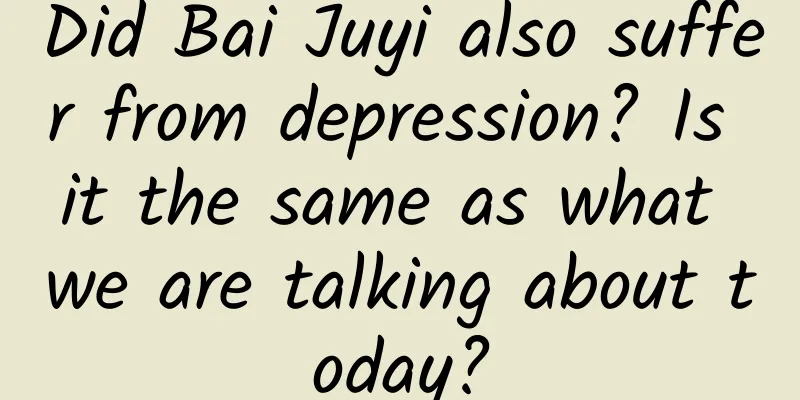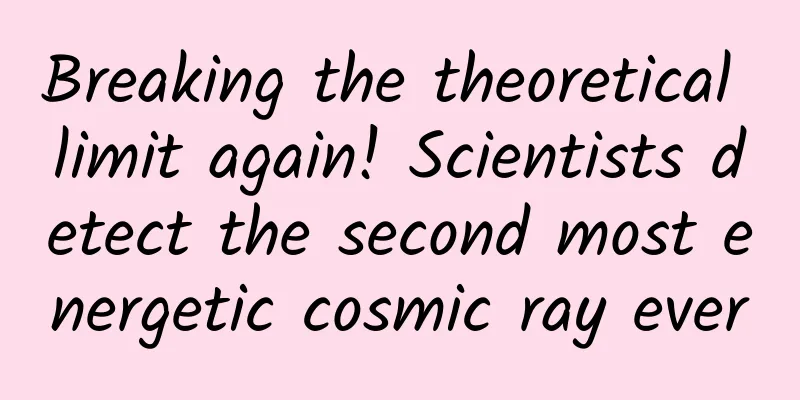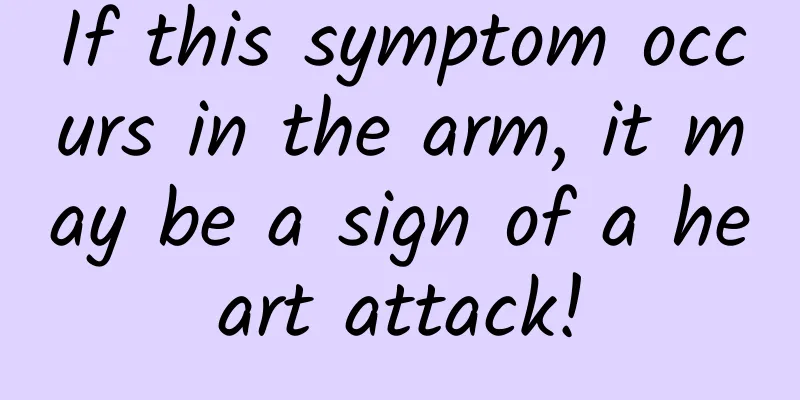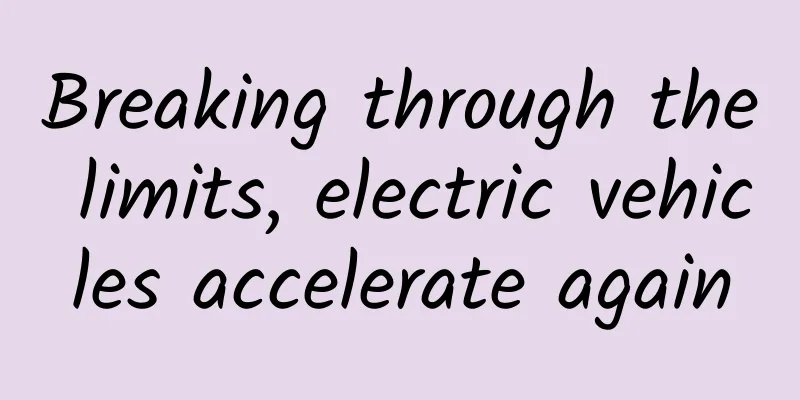Did Bai Juyi also suffer from depression? Is it the same as what we are talking about today?

|
Therefore, the verses written on the river bridge only express sadness for parting; the poems written on the lake bank only express resentment and longing. I am so lost and depressed that I have no time to think about anything else. ——Bai Juyi's "Letter to Yuan Jiu" Image source: Yang Jingyi Was Bai Juyi also "depressed"? In the article "Letter to Yuan Jiu" written by Bai Juyi, a famous poet in the Tang Dynasty, he once mentioned "confusion and depression". Is his "depression" the same as the "depression" that modern people often talk about? First of all, I want to explain that a common misunderstanding about depression is that "depression means a bad mood." A bad mood may just be the same as what Bai Juyi wrote, but it is quite different from depression in today's medical literature. Depression is not just a bad mood, it usually has the following four symptoms "Depressed mood" is indeed one of the diagnostic criteria for depression, but the connotation of depression is far more than just a bad mood. The symptoms of depression are roughly manifested in four aspects. Some manifestations of depression (Image source: veer gallery) First of all, in terms of emotions, depression actually corresponds to a group of emotions, which include, in addition to sadness, feelings of guilt, failure, and punishment. Depressed people often have a low opinion of themselves and are prone to denying their own value, which leads to a sense of failure. Sometimes some patients may not be good at expressing their emotions and think that "there is nothing wrong with their lives", but their low mood can be inferred from their easy tears or continuous sighing. The self-guilt of patients with depression may sometimes be out of touch with reality, such as thinking that "I have committed a great sin and feel sorry for my family" or even that "my existence may affect the appearance of the city." Irritability is also a common symptom of depression, and this feature is more obvious in children and adolescents. Secondly, symptoms of depression also manifest in cognitive aspects, such as suicidal thoughts, concerns about health, slower thinking, difficulty making decisions, and feelings of hopelessness. Suicide is a very serious issue. It is the leading cause of death among people aged 15-34 in my country. In addition, the suicide rate among the elderly in my country is higher than that among the young. When someone commits suicide, people often ask what happened before the suicide. In fact, no matter how extreme the event an individual experiences, it does not mean that the person who experiences the event will commit suicide. One of the common causes of suicide is depression. Health is indeed something that each of us should care about, but excessive worry about health may affect our lives. Cognitive symptoms of depression may also include difficulties with memory and attention. They may have selective attention and enhanced memory for content that evokes negative emotions. Lack of hope is also a characteristic of depression. This sense of hopelessness is not only directed at the present moment, but also includes the future. In psychology, there is a term called "tunnel vision". In other words, they seem to be observing the world and predicting the future in a direction where they cannot see the light. Lack of hope is not an objective indicator. A person who is trapped in depression and cannot see hope may be seen by others as a very successful person, a person who is considered excellent by everyone, or even an enviable person. Third, depression also has behavioral manifestations . These manifestations are often observable by outsiders and may be a decrease in work or study efficiency. Sometimes individuals are unable to complete the study or work they were able to complete before, and sometimes they can complete the study or work, but it requires more time and energy. Decreased interest is also a behavioral manifestation of depression. For example, a person who used to like playing table tennis and has played for decades may feel that table tennis is no longer important to him after becoming depressed. Social withdrawal is also common . Corresponding to the table tennis example, a depressed individual may not only no longer actively invite his teammates to play, but may even be indifferent to his teammates' calls. Fourth, depressive symptoms can also manifest themselves physically . Sleep disturbance is often the first symptom that people with depression complain about to their doctors. Most people will complain that they are sleeping too little, but some people may be sleeping too much. Changes in appetite and accompanying changes in weight are also two interrelated physical symptoms of depression. People often think that depressed individuals will have a loss of appetite and a significant weight loss. However, for some individuals, the symptoms may be the opposite: appetite becomes better and weight increases accordingly. The author speculates that the reason may be the current popular dieting. When dieters are in a bad mood, they tend to eat more, rather than the typical "too sad to eat" situation. Loss of energy is also a physical symptom of depression. Depressed individuals often feel "tired." This tiredness is different from fatigue after a day's work: fatigue can be relieved by rest, while the tiredness of depression is more difficult to relieve. For some severely depressed individuals, even completing tasks such as dressing and washing may be difficult. The highest risk of suicide for some patients with severe depression is not when their symptoms are the most severe , because when their symptoms are the most severe, they may not have the energy to complete their suicide plan. It is precisely when they begin to recover that the risk of suicide is highest. Loss of libido is also one of the physical symptoms of depression. In addition, the physical manifestation of depression symptoms may also be pain , which may occur locally or throughout the body. Some people are smiling, but they are actually depressed There is no absolute indicator of which category the above symptoms should be classified into. For example, although guilt is classified as an emotion in this article, thinking plays a decisive role in the formation of this feeling. A basic assumption of psychology is that emotions are the product of thinking, rather than simply a reaction to external events. In other words, it is not what has happened or is going to happen that causes a certain emotion, but our interpretation style and beliefs about these things that induce emotions. A simple example is that traffic jams or long waits at red lights can easily cause anxiety, but in fact the relationship between traffic jams and anxiety may be through explanations such as "I'm going to be late, and being late will..." This kind of explanation process is very important, but it happens too quickly, almost in an automatic mode, so people ignore the existence of this step. Image source: veer gallery Therefore, the existence of the term "smiling depression" in Chinese may reflect people's lack of comprehensive understanding of depression. This term only pays attention to a small part of the emotion-related part of depressive symptoms. In fact, even if depressive symptoms are only related to emotions, they are difficult to detect because people are very poor at recognizing other people's emotions. Sometimes, couples may have such a situation: one party says, "Why don't you know I'm unhappy?" or "You clearly knew I was unhappy but still did that." The other party is often confused when hearing this because they did not realize that the other party was unhappy. This example shows that even for people with very close relationships, if we do not disguise our emotions, the other party may not be able to recognize our emotions. In psychology, this phenomenon corresponds to the " emotional transparency effect ," which corresponds to the illusion that we often overestimate the degree to which others perceive and recognize our emotions. Please note that this is based on the premise of not wanting to disguise emotions. If a person wants to disguise, then hiding his emotions in front of unfamiliar people is not a difficult thing. How to determine "I am depressed"? It's actually a question "I feel depressed." Is the person who says this really depressed? People often suggest "take a test on a scale." So what exactly is a scale? Below are three items from a depression scale. The following questionnaire has 20 questions in groups of four. Please read each group of four statements carefully and then choose the sentence in the group that best describes your feelings in the past week , including today . Please circle the number next to the sentence to indicate your choice. Please read each group of four sentences before making a choice in this group of statements. (1) 0 I am not particularly depressed about the future. 1. I feel depressed about the future. 2 I feel like I have nothing to look forward to. 3. I feel that the future is hopeless and that things will not get better. (2) 0 I am not disappointed in myself. 1. I am disappointed in myself. 2. I hate myself. 3. I hate myself. (3) 0 I don't feel like a loser. 1. I feel like I am a bigger failure than the average person. 2 When I look back on my life, I see a lot of failures. 3. I feel like a complete failure. However, when you are in a bad mood and take similar tests, you often get a variety of results. When taking the depression scale, you find that you are depressed, and when taking the anxiety scale, you find that you are anxious. Why is that? In fact, it is not easy to distinguish between anxiety and depression. Some scholars even believe that the underlying characteristics of anxiety and depression may be the same, but the same underlying characteristics induce different symptom groups in different people: anxiety is the main symptom in some people, depression is the main symptom in some people, and both anxiety and depression may be obvious in others. How to simply and effectively distinguish between anxiety and depression is not an easy task for scholars. The author has been engaged in questionnaire development and introduction for many years. One of the tasks is to introduce a Western scale for measuring depression, anxiety and stress into China, because this scale can better measure anxiety and depression with fewer questions. In fact, the original intention of the developers of the scale to develop this scale was to design a simple tool that can effectively distinguish between anxiety and depression. So, they listed the most representative anxiety symptoms and the most representative depression symptoms, and formed a scale after optimization. After collecting data from a certain number of people, statistical methods can be used to answer the questions on the scale and divide them into several categories. Obviously, the developers expected that this scale could be divided into two categories, namely anxiety symptoms and depression symptoms. Interestingly, the data analysis actually divided it into three categories: in addition to anxiety and depression, a third type of symptoms appeared. The third type of symptoms was named "stress". Therefore, the "Depression Anxiety Stress Scale" widely used around the world may have been originally titled "Depression Anxiety Scale". This example also shows that depression and anxiety symptoms are not so easy to distinguish. A bad mood may correspond to depression or anxiety. In addition, whether a certain expression corresponds to depression or anxiety may be different in different cultures. Introducing a scale used in one culture into another culture is far more than just finding someone who is good at both languages to translate it. It is a very rigorous and meticulous work that requires following several scientific procedures. There is an item in the original scale of the Depression Anxiety Stress Scale, "I feel depressed and frustrated." This item is used to measure depressive symptoms in Western culture. However, after testing thousands of college students in my country, through data analysis, it was found that the question "I feel depressed and frustrated" is not the best solution to be classified as depression, but should be attributed to the dimension of stress. In addition, in another study, my colleagues also found that the question "I feel sad and depressed" should also be placed in the "stress" category among domestic college students. Of course, the findings among college students cannot be directly extrapolated to other age groups. When writing popular science articles, we can relax this standard a little. If these two questions among college students are indeed not depression but stress, the author speculates that there are two possibilities: First, our ability to recognize negative emotions is actually quite low, so when we say something that seems to be related to depression, this expression is not only related to depression, but also to anxiety. Second, we may use words like "depression" to express the pressure we feel in our lives. An example is when you hear someone say "this thing really makes me depressed", the meaning behind it is often "this thing gives me a lot of pressure." Therefore, when we are in a bad mood, what we experience is not necessarily depression. How to distinguish between depression and depression, using the "continuous" approach If we use a commonly used depression scale to measure depression, in fact, many people will not score 0 on every item. In other words, many people have more or less symptoms of depression. Therefore, from a scientific research perspective, we no longer use the dichotomous view of "disease or non-disease" to view depression, but view it as a continuum. At one end of the continuum are those individuals whose symptoms are so pronounced that they qualify for a diagnosis of depression, and at the other end are those individuals who are very lucky and don't have even a little bit of depression. Most people are somewhere in between the two ends of this continuum . If you have some symptoms, but they don't cause you too much trouble, don't affect your daily life too much, and don't last too long, then you can be considered within the normal range. Using a continuum perspective to understand depression also has advantages for medical practice. A friend of mine took a depression questionnaire at the hospital and the result showed a high score, indicating "major depression", so he thought he had severe depression. In fact, "major depression" and "very severe depression" are not the same thing. The results of the questionnaire can only show that the score of depression symptoms is relatively high, but even if the symptoms are obvious and the score is relatively high, it may not meet the diagnostic criteria for major depressive disorder. Image source: veer gallery The diagnosis of depression can only be made by a psychiatrist, and questionnaires cannot replace diagnosis. The diagnosis of depression has very strict standards. In addition to meeting the diagnostic symptom requirements, it is also necessary to consider the duration of the symptoms, the individual's degree of pain, the impact on function, and some exclusion criteria. Depression is accompanied by changes in neurotransmitters. If it really meets the diagnosis of depression, then the doctor will use antidepressants. The doctor did not prescribe antidepressants for this friend, so it can be inferred that he did not meet the criteria for depression, let alone "very serious depression." Of course, not meeting the criteria for depression does not mean that there is no pain. In short, one advantage of looking at depression from a continuous rather than a binary perspective is that you don’t have to interpret “severe depression” assessed by the questionnaire as “very severe depression.” Conclusion Now you should understand that over thousands of years, the connotation and extension of the word "depression" have changed a lot. When Bai Juyi, who was demoted to Sima of Jiangzhou, talked about his poetry theory with his old friend Yuan Zhen (ranked ninth, so he was called Yuan Jiu), he wrote "Wandering Depression". Later, the development of medicine borrowed the word "depression" to describe a group of symptoms, which led to some misunderstandings about the word "depression" in our daily life. As the public understands depression and depression in medicine, these misunderstandings should gradually disappear. I hope this article can give you more understanding of "depression" and help yourself and others when needed. Image source: veer gallery Author: Wang Kui This article is from the "Science Academy" public account. Please indicate the source of the public account when reprinting. |
<<: Look, this is a "strip horse", you can sweep it!
>>: What would you see if you looked down from directly above the North Pole?
Recommend
How to create a bar chart in SwiftUI
Introduction A bar chart presents categories of d...
Apple's Tian Ji horse racing, iPhone 14 inventory may reach 95 million units, domestic brands are under severe pressure
When Apple started playing the Tian Ji horse raci...
Advertising creative production methodology
I believe that many of my friends have also seen ...
Apple's large-screen iPhone: a passive upgrade without innovation
Leaked blunder The last time an Apple product was...
How to improve APP’s next-day retention?
What is next-day retention? Next-day retention, o...
Baotou SEO Training: How to quickly improve website inclusion and weight?
How to increase website entry? 1.URL submission T...
What creative elements are there in the hot copywriting for the Winter Solstice?
At 0:28 on December 22, 2017 (Friday), we will us...
One year after the landing of Tianwen! Did Zhurong discover water on Mars? It has something to do with manned Mars exploration
On May 15, 2021, the Tianwen-1 probe successfully...
Case Analysis | A Brief Discussion on Task-based Activity Operations
Recently I found that my friends all sent invitat...
What kind of team is more likely to succeed in making games?
[[147743]] I have been observing some teams makin...
2021 Nobel Prize in Physiology or Medicine: Scientific explanation of the body's sense of heat, cold and touch
Written by | Fanpu At 11:30 a.m. local time on Oc...
Do self-produced dramas have to rely on fresh actors to be interesting? Sohu Video tells you the answer
Appearance is king, and handsome actors dominate ...
Can contact with shopping receipts cause cancer? Is bisphenol A in machine-printed receipts really that scary?
gossip "Bisphenol A in machine-printed recei...
What are the requirements for a bidding promotion creative?
There should be at least 1-2 wildcards in the tit...
JD Power: 2024 China New Energy Vehicle Customer Experience Value Research
The study uses the Customer Experience Value Inde...






![[Practical] How to create a Facebook ad?](/upload/images/67cc1abe9d4ab.webp)


